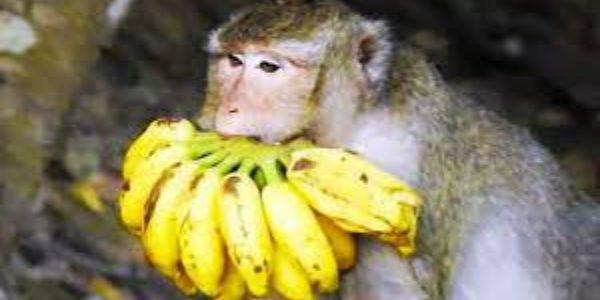Monkeys are categorized into three groups, namely; old world monkeys, apes, and new world monkeys. Apes are only found in Africa while old-world monkeys are available in Asia and Africa. New world monkeys largely exist in America.
Monkeys are omnivorous. Fruits, leaves, seeds, insects, grass, and eggs form the main part of the monkey diet. Monkeys’ diets keep changing depending on the location and the type of food available. To an extent, some monkey species have developed specialized digestive systems to digest specific food.
Leaf eaters such as howler and colobus have long extensive digestive tracts for processing hard leafy nutrients. Their stomach is designed to ferment the plant matter. Gelada monkey is a herbivore and purely eats grass.
Monkeys live in the wild and therefore eat natural wild foods like fruits and insects. Omnivorous monkeys eat fruits like bananas, mangoes, pomes, fleshy fruits, leaves, grass, drupes, seeds, buds, and flowers. City monkeys found in animal zoos and human settlements eat fruits thrown to them by man and fruit leftovers in the trash.
In general, monkeys eat bananas because they are rich in water and sugar. Bananas are also nutritious and easy to digest thus improving their daily functioning. This makes bananas an ideal monkey food.
How Many Many Bananas Do Monkey Eat Per Day?
The number of bananas that monkeys can eat per day significantly varies depending on many underlying factors. Some of these factors are monkey species, size, and environment.
Monkeys cannot eat wild bananas since they contain inedible fruits containing large seeds. Hence monkeys must cross to human habitation to find edible domesticated bananas.
Smaller monkeys such as marmosets do not eat bananas. Instead they eat insects and other fruits. In the absence of other fruits, average-sized primates will eat approximately five bananas per day.
Longhurs, one of the monkey species is known to eat bananas in the wild. They peel off the skin before consuming them whole. They also use wild bananas as a tool for cracking hard nuts and seeds by hitting them against rocks or other tough surfaces.
Most zoos in the world have stopped feeding monkeys bananas. Conservationists argue that feeding monkeys domesticated bananas for long is a threat to their health.
The high sugar content contained in a domesticated banana is linked with diabetes in monkeys. It is said that domesticated bananas are associated with digestive problems in monkeys since their digestive tracts are made to digest fibrous food with very low sugar content. It was observed that monkeys who are fed domesticated bananas continued to become less and less active.
Monkeys love bananas as compared to other foods. Studies were conducted around 1936 to confirm which food monkeys would go for when several foods were available. In the study, fruits, vegetables, nuts, and bread were offered to monkeys and then it was observed which one they consume more. Bananas ranked immediately after grapes, nuts, and bread were last.
Do Monkeys Eat Banana Peels?
Monkeys also eat banana peels. On most occasions, monkeys are known to peel bananas and eat fleshy parts. However, in a dire situation, monkeys gobble up banana peels discarded by man. This may be due to acute starvation.

